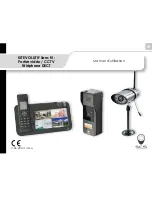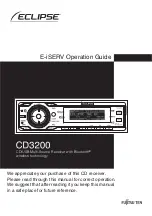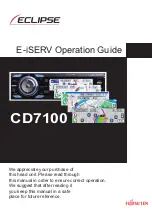
Now that you know how to set up and use one of the hubs/headsets properly, it is time to set up the
other hub/headset (the same as you have with the first one) and then start communicating between
the two hubs via the wireless link.
Place the two hubs side by side, labels down and with both battery covers removed (with good batteries
correctly installed, or bike powered). Connect each headset (within 10 seconds) to power the hubs and
establish the wireless link. You will know when the wireless link is established when both hubs red
L.E.D.’s are constantly lit (you may notice that about every 4 seconds the lit L.E.D./s blinks off just for
a split second, this is normal).
If someone is available to assist, get them to copy you and hold their microphone/speaker in position
and speak positively to each other via the wireless link. You will notice that when you speak and operate
your VOX that your speech is transmitted, via the wireless link and you both hear your voice as your
side-tone provides you with important audio confirmation that you have communicated properly. The
system is DUPLEX and so you can both speak at the same time, so practice this for a while to get used
to it.
While testing you may notice a slight echo if you can hear both hubs headset speakers. Please do not
worry about this as it will not be noticeable when the headsets are installed into your helmets, or while
riding.
Rider-to-Passenger Mode
At the time of factory testing and the two hubs were first linked, one became the MASTER HUB (marked
M on the test label within the battery compartment) and the other became the SLAVE HUB (marked S
on the test label in the battery compartment).
It is important to connect both hubs headsets within 10
seconds of each other, in order to establish the wireless link for rider to passenger use. After this time,
if your hub has not found and connected with the other hub, it will stop searching as part of its battery
saving design. If this happens and you want to re-establish the wireless rider to passenger link you will
have to disconnect and then reconnect both headsets within 10 seconds of each other.
Rider-to-Rider Mode
If you want to split the two hubs between two bikes and use them independently with optional bike-to-
bike radios, you can simply power up the master hub first (for about 30 seconds) BEFORE turning on
the slave hub. This will prevent the wireless link establishing, which not only save battery power but
also ensures that you are only communicating via the bike-to-bike radios, and not also via the wireless
link when close together which would otherwise cause an undesirable echo effect.
Please remember to disconnect each hubs headset in order to turn each hub off when not being used,
as leaving the headsets connected while not in use wastes battery power.
CONNECTING THE TWO WIRELESS HUBS
HEADSET INSTALLATION
Because Autocom systems work so much better than other systems, it is easy for people to think its
working great even when it’s not set up and used properly and only giving you perhaps 30% of what
is really has to offer. This is why we recommend that you to test the headset out of the helmet with
some music, so that after installation you can hear if it sounds right and adjust as required. Using music
is the best way of hearing this, even if you do not intend using music in future.
The plug-in boom microphone/s supplied in the kit is our most universal boom designed to fit most full
face, flip front and open face helmets, but please note; most open face and enduro/moto-cross style
helmets, including flip-front helmets if you want to ride with it open, will require the
optional open
face conversion kit
(Part 2156) to prevent excessive direct wind blast getting to the microphone. The
headset is not designed to work with
1
⁄
2
helmets (chip style) which normally require a much longer boom
and perhaps some additional padding to mount the speakers over your ears. Replacement consumable
microphone coverings (Part 2166) are available from your dealer. The optional long boom microphone
(Part 2075) is similar to our standard boom microphone but is 35mm (1
3
⁄
8”
) longer and is ideal for larger
open face helmets.
There are far too many different helmet types available to be able to fully describe every possible
installation here, and one must also consider that each year various helmet designs change, so these
instructions are designed as a basic guide only. Please see your local Autocom dealer or visit our website
www.autocom.co.uk
for more detailed specific helmet installations. Most authorised Autocom dealers
are trained and experienced with helmet fitting.
Please note; helmets that have straps that go directly over your ears may not lend themselves for a
good headset installation, as the speakers have to sit either on top or behind the straps, which can
make them uncomfortable or out of position which will reduce the sound quality. This is beyond our
control and if our speakers do not fit, nor will any others. It is a good idea to remember this next time
you choose a helmet. You can overcome this problem by using optional in-ear speaker plugs that can
replace the standard over the ear type speakers. Our optional Part 2091 allows you to use most types
of in-ear speaker plugs with your system.
Some helmets may not lend themselves to be installed as we have suggested and so may require
alternative methods. Please take plenty of time to carefully consider all these basic principles, together
with the installation diagrams and your own helmet design to see if you can establish any similarities
that may help you with installation. If you are unsure about any of the above then please contact your
supplier or Autocom for help and advice.
DO NOT CUT YOUR HELMET!
8
Kit LIW Instructions.qxd 5/6/09 2:03 pm Page 8


































